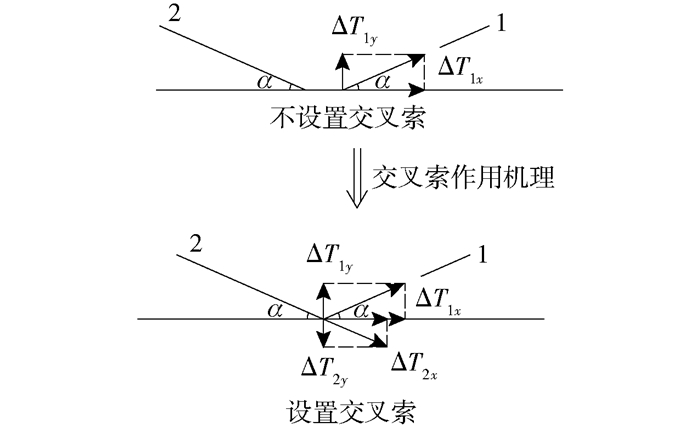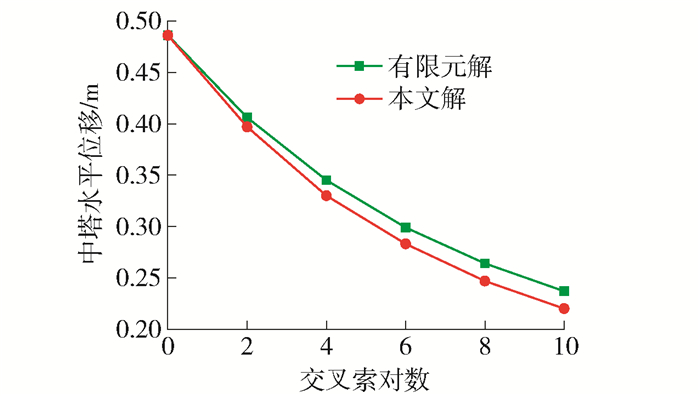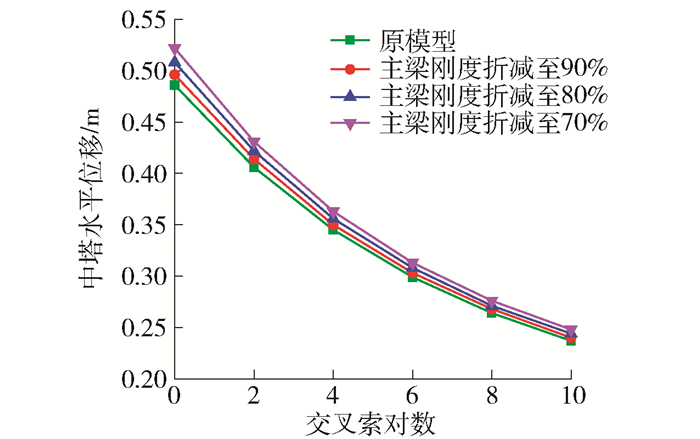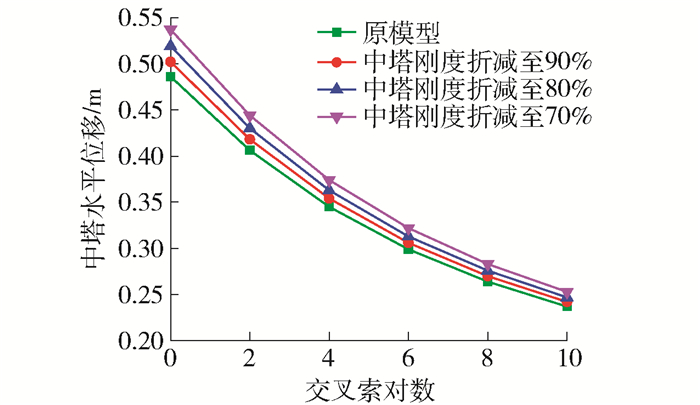Estimation Formula for Longitudinal Restraint Stiffness of the Middle Tower of Multi-tower Cable-stayed Bridge With Crossed Cables by Considering the Effect of Tower and Beam
-
摘要:
为深入研究交叉索的作用机理,基于变形协调原理,忽略边塔水平小位移,推导了在塔、梁自身刚度影响下,交叉索对多塔斜拉桥中塔约束刚度的估算公式,并进行算例验证.研究结果表明:推导的公式解与有限元解的误差在8%以内,满足斜拉桥概念设计的精度要求.跨中交叉拉索可以使主梁挠度减小,进而提高多塔斜拉桥的整体刚度.多塔斜拉桥整体刚度随交叉索数量的增加而增大,设置10对交叉索后中塔位移减小量高达51%,但刚度增大趋势逐渐减缓.对于交叉索多塔斜拉桥而言,桥塔自身刚度的改变对中塔抗推刚度的影响大于主梁,但二者皆小于跨中交叉索对中塔抗推刚度的影响.
Abstract:With the construction of Queensferry bridge in Scotland, the multi-tower cable-stayed bridges with crossed cables have entered the field of bridge engineers. In order to explore the action mechanism of crossed cables, considering the effect of tower and beam and ignoring the small level displacement of the side tower, based on the principle of deformation coordination, an analytic formula for calculating the longitudinal restraint stiffness of the middle tower of multi-tower cable-stayed bridge with crossed cables was deduced, and a numerical example was carried out. The results show that the error between the formula and finite element is within 8%, and it can meet the requirements of the conceptual design of cable-stayed bridge. Crossed cables can make the beam deflection decrease, thus increasing the overall stiffness of the cable-stayed bridge. The overall stiffness of multi-tower cable-stayed bridge rises as the number of crossed cables increasing.The displacement of middle tower reduction is up to 51% after 10 pairs of crossed cables are set, while the stiffness increase gradually slows down. The change of the stiffness of the tower's effect on longitudinal restraint stiffness of the middle tower for multi-tower cable-stayed bridge is greater than that of the main beam, but the crossed cables play more important roles in increasing the stiffness of the structure.
-
在英国苏格兰昆斯费里辽阔的福斯湾上,2011年4月昆斯费里大桥(Queensferry Crossing)开始建设,该桥为主跨650 m的三塔斜拉桥,首次采用跨中交叉布索的设计方法以提高中塔抗推刚度. 2017年9月4日昆斯费里大桥(福斯新桥)建成通车,标志着世界上首座跨中交叉布索的多塔斜拉桥的诞生[1-3].
众所周知,多塔斜拉桥在不平衡活载作用下,由于中塔缺少锚索或辅助墩等类似构件的约束导致结构产生较大的变形,针对这一问题,国内外学者对提高中塔刚度的方法进行了深入探索[4-11].最直接的方法是增大主梁、桥塔刚度,如马拉开波桥、米约高架桥、希腊里翁-安蒂里翁桥等,文献[12]针对一主跨580 m的三塔斜拉桥展开分析,将其主梁刚度提高1~6倍,中塔位移相应减小,但密索体系斜拉桥主梁刚度相对于跨径很小,只有很大程度地提高主梁刚度才能有效增大结构整体刚度,且主梁刚度的增大势必带来自重增大的负担,不利于结构受力.文献[12]将桥塔刚度提高1~20倍,发现该提高对桥塔位移的影响并不显著,且大幅提高桥塔刚度很难实现,建议采用A字型桥塔,但这一方法势必带来庞大的基础施工问题. Gimsing[13]提出采用修正缆索体系的方法来提高多塔斜拉桥中塔刚度,包括采用水平加劲索、倾斜加劲索、交叉索等.我国香港汀九大桥即采用倾斜加劲索设计而成.对于大跨径多塔斜拉桥,前2种加劲方式的效果因长缆索的垂度效应而大打折扣,交叉索因其加劲效率可以通过调整设置数量来实现,受到更多学者的推崇,众多学者通过分析计算和理论研究均认为这一方法有效地提高了结构的刚度[14-16].
目前针对交叉索的作用机理研究较少,文献[17]对我国某三塔铁路斜拉桥进行了缩尺模型试验,对比3种缆索体系的加劲效率,设置水平缆索、倾斜缆索的加劲效率分别为18%、11%,设置1对交叉索加劲效率为6%,设置2对交叉索加劲效率为10%,这一试验充分说明了交叉索加劲效率可通过设置数量来调整,且每增设1对交叉索,加劲效率都会大幅提高.文献[18]提出不考虑塔梁刚度影响下交叉索对中塔的约束刚度推导公式,阐明交叉索作用机理是跨中梁段的重量在交叉索中重新分配,导致索力变化,约束中塔变形.其推导过程中假设塔底铰接,主梁刚度很小,这与实际结构差异较大.本文在文献[18]的启发下,参考文献[19-20]中关于传统斜拉桥中塔刚度推导的方法,得出考虑塔梁自身刚度影响下的交叉索对中塔的纵向约束刚度公式.
1. 交叉索对中塔约束刚度的理论推导
多塔斜拉桥由于中塔缺少锚索或辅助墩等类似构件的约束导致结构产生较大的变形,如图 1所示.
为了解决这一问题,以三塔斜拉桥为例,采用常见的约束方式,即中塔处塔梁固结,边塔处塔梁分离的结构体系.在推导过程中,将跨中交叉索简化为1对交叉索,如图 2所示,且不计除交叉索外其他斜拉索的影响.
水平力作用下,由于边塔处塔梁分离,且受到端锚索、辅助墩的约束,边跨拉索、边塔变形较小,为简化推导,忽略边塔塔顶水平位移,基于以下假定:
1) 活载作用下桥塔及斜拉索的变形较小,认为拉索倾角没有变化.
2) 拉索材料为线弹性,考虑拉索的弹性伸长.
3) 主梁无纵漂.
4) 忽略主梁轴向变形以及桥塔的压缩变形.
5) 边塔水平位移很小,忽略不计.
位移的变化量用δ表示,力的变化量用Δ表示,基于以上假定,结构变形及参数见图 3.
图 3中:E1为桥塔自身的弹性模量;I1为桥塔抗弯惯性矩;E2为主梁自身的弹性模量;I2为主梁抗弯惯性矩;E3为斜拉索的弹性模量;A3为斜拉索截面积;δa为外力作用下中塔水平位移;δh为外力作用下主梁上挠位移;交叉索索力为T1、T2;拉索长均为l;与主梁的夹角为α;桥塔高H;桥面以上塔高h;主跨跨径为2a;水平外力为p.
由结构力学知桥塔自身抗推刚度为
$$ {K_{\rm{T}}} = \frac{{3{E_1}{I_1}}}{{{H^3}}} $$ 文献[20]给出斜拉桥主梁x长度处的抗弯刚度为
$$ {K_x} = \frac{{6{E_2}{I_2}a}}{{{x^2}{{\left( {2a - x} \right)}^2}}} $$ 跨中主梁自身抗弯刚度为
$$ {K_{\rm{L}}} = \frac{{6{E_2}{I_2}}}{{{a^3}}} $$ 2次利用变形协调原理的求解思路为:当p作用于中塔时,p可以分为p1和p2两部分. p1使得中塔在自身刚度下发生变形,p2使得拉索1伸长.拉索1近塔端的水平位移由两部分组成,一部分是拉索1自身伸长引起的,另一部分是由于主梁上挠使得拉索1近塔端产生的水平位移.以中塔塔顶为研究对象,根据变形协调原理,p1作用下的塔顶水平位移应与p2作用下的拉索1近塔端水平位移相等,均等于δa.
拉索1索力变化带来的影响可以分为两部分,一部分使得主梁上挠,另一部分使得拉索2压缩.忽略边塔塔顶位移,以跨中主梁为研究对象,根据变形协调原理,主梁上挠位移与拉索2近梁端竖向位移相等,均等于δh.
由此建立平衡方程,即可求解δa的值,进而求得考虑桥塔、主梁自身刚度影响下的交叉索对中塔的约束刚度.由解题思路,可知
$$ p = {p_1} + {p_2} $$ (1) $$ {\rm{ \mathsf{ δ} }}a = \frac{{{p_1}}}{{{K_{\rm{T}}}}} $$ (2) 根据力的平衡,可得拉索1索力变化量为
$$ \Delta {T_1} = \frac{{{p_2}}}{{\cos \alpha }} $$ (3) 拉索1的伸长量为
$$ \delta {l_1} = \frac{{\Delta {T_1}l}}{{{E_3}{A_3}}} = \frac{{{p_2}l}}{{\cos \alpha {E_3}{A_3}}} $$ (4) 拉索1伸长引起的中塔水平位移为δa1,见图 4.
由图 4可知
$$ {\rm{ \mathsf{ δ} }}{a_1} = \frac{{{\rm{ \mathsf{ δ} }} {l_1}}}{{\cos \alpha }} = \frac{{{p_2}l}}{{{{\cos }^2}\alpha {E_3}{A_3}}} $$ (5) 如图 5所示,ΔT1的竖向分力为ΔT1y,其一部分被拉索2索力变化的竖直分力ΔT2y平衡,另一部分使得主梁产生向上的挠曲变形.该处力学分析清晰地反映了跨中交叉索的作用机理,在传统斜拉桥中,ΔT1y完全用来使得主梁发生挠曲变形,结构将产生较大的形变,而在交叉索多塔斜拉桥中,当中塔发生纵向位移时,梁段的重量在交叉背索中重新分配,使得拉索1索力增大ΔT1,拉索2索力减小ΔT2,ΔT1被拉索2平衡了一部分,使得主梁向上挠曲的力减小为ΔT1y-ΔT2y,故主梁变形减小,结构刚度增大.
忽略主梁的轴向变形,根据力的平衡,可知主梁受到的竖向力T3为
$$ {T_3} = \Delta {T_{1y}} - \Delta {T_{2y}} $$ (6) 将ΔT1y=ΔT1sin α,ΔT2y=ΔT2sin α代入式(6),则
$$ \Delta {T_1}\sin \alpha = \Delta {T_2}\sin \alpha + {T_3} $$ (7) 得
$$ {\rm{ \mathsf{ δ} }}h = \frac{{{T_3}}}{{{K_{\rm{L}}}}} $$ (8) 再求解拉索2的压缩变形量为
$$ {\rm{ \mathsf{ δ} }}{l_2} = \frac{{\Delta {T_2}l}}{{{E_3}{A_3}}} $$ (9) δl2的竖向分量为δl2y,见图 6.
根据图 6可知
$$ {\rm{ \mathsf{ δ} }}{l_{2{\rm{y}}}} = \frac{{{\rm{ \mathsf{ δ} }}{l_2}}}{{\sin \alpha }} = \frac{{\Delta {T_2}l}}{{{E_3}{A_3}\sin \alpha }} $$ (10) 由于边塔塔梁分离,在p的作用下边塔塔顶变形较小,忽略边塔的塔顶水平位移,由变形协调原理,可得
$$ {\rm{ \mathsf{ δ} }}h = {\rm{ \mathsf{ δ} }}{l_{2y}} $$ (11) 即
$$ \frac{{{T_3}}}{{{K_{\rm{L}}}}} = \frac{{\Delta {T_2}l}}{{{E_3}{A_3}\sin \alpha }} $$ (12) 主梁上挠引起拉索1近塔端水平位移,见图 7,由于变形很小,认为α1≈α2,则有tan α1≈tan α2,可得
$$ \frac{{{\rm{ \mathsf{ δ} }}{a_2}}}{h} = \frac{{{\rm{ \mathsf{ δ} }}h}}{a} $$ (13) 则
$$ {\rm{ \mathsf{ δ} }}{a_2} = {\rm{ \mathsf{ δ} }}h\frac{h}{a} $$ (14) 以中塔塔顶为研究对象,根据变形协调原理,有
$$ {\rm{ \mathsf{ δ} }}a = {\rm{ \mathsf{ δ} }}{a_1} + {\rm{ \mathsf{ δ} }}{a_2} $$ (15) 即
$$ \frac{{{p_1}}}{{{K_{\rm{T}}}}} = \frac{{{p_2}l}}{{{{\cos }^2}\alpha {E_3}{A_3}}} + \frac{{{T_3}h}}{{{K_{\rm{L}}}a}} $$ (16) 联立式(1)(3)(7)(12)(16)可知,该方程组中含有p1、p2、ΔT1、ΔT2、T3共5个未知数,共5个方程,方程组可解.
将式(1)(12)代入式(16)得
$$ \frac{{p - {p_2}}}{{{K_{\rm{T}}}}} = \frac{{{p_2}l}}{{{E_3}{A_3}{{\cos }^2}\alpha }} + \frac{{\Delta {T_2}lh}}{{{E_3}{A_3}a\sin \alpha }} $$ (17) 由式(3)(7)得
$$ \frac{{{p_2}\sin \alpha }}{{\cos \alpha }} = \Delta {T_2}\sin \alpha + \frac{{\Delta {T_2}l{K_{\rm{L}}}}}{{{E_3}{A_3}\sin \alpha }} $$ (18) 化简得
$$ \Delta {T_2} = \frac{{{p_2}{E_3}{A_3}{{\sin }^2}\alpha }}{{\cos \alpha \left( {{E_3}{A_3}{{\sin }^2}\alpha + {K_{\rm{L}}}l} \right)}} $$ (19) 将式(19)代入式(17),根据几何关系得
$$ p - {p_2} = {p_2}\left[ {\frac{{3{E_1}{I_1}{l^3}}}{{{H^3}{E_3}{A_3}{a^2}}} + \frac{{3{E_1}{I_1}{l^3}{h^2}a}}{{{H^3}\left( {{E_3}{A_3}{h^2}{a^3} + 6{E_2}{I_2}{l^3}} \right)}}} \right] $$ (20) 令
$$ \gamma = \frac{{3{E_1}{I_1}{l^3}}}{{{H^3}{E_3}{A_3}{a^2}}} + \frac{{3{E_1}{I_1}{l^3}{h^2}a}}{{{H^3}\left( {{E_3}{A_3}{h^2}{a^3} + 6{E_2}{I_2}{l^3}} \right)}} $$ (21) 则有
$$ p - {p_2} = \gamma {p_2} $$ (22) $$ {p_2} = p\frac{1}{{1 + \gamma }} $$ (23) 当结构参数、材料确定之后,γ是一个可以求解的常数,由式(21)(23)可求解出p2的值,从而由式(1)求解得p1,它的物理意义是设置跨中交叉索的三塔斜拉桥中塔塔顶受到p的作用后,中塔自身分配的力.
$$ {p_1} = p\frac{\gamma }{{1 + \gamma }} $$ (24) 求解出p1后,可得
$$ {\rm{ \mathsf{ δ} }}a = \frac{{{p_1}}}{{{K_{\rm{T}}}}} = \frac{{\gamma p}}{{\left( {1 + \gamma } \right){K_{\rm{T}}}}} $$ (25) 则中塔纵向约束刚度为
$$ K = \frac{p}{{{\rm{ \mathsf{ δ} }}a}}\frac{{1 + \gamma }}{\gamma }{K_{\rm{T}}} $$ (26) 此处求解的中塔纵向刚度是在图 3结构体系下的刚度,即中塔抗推刚度是由交叉索、主梁、桥塔三者相互作用下的求解结果.则有
$$ K = {K_{{\rm{T - T}}}} + {K_{{\rm{T - L}}}} + {K_{{\rm{T - J}}}} $$ (27) 式中:KT-T为仅桥塔刚度对中塔刚度的贡献;KT-L为仅主梁刚度对中塔刚度的贡献;KT-J为仅交叉索对中塔刚度的贡献,由于此处没有计入结构普通斜拉索的影响,故本文需要求解出KT-J,再与同等条件下不设置交叉索的多塔斜拉桥中塔刚度值相加,即可求得设置交叉索后的整体结构体系下的中塔刚度值.
根据上述思路,易知
$$ {K_{{\rm{T}} - {\rm{T}}}} = \frac{{{p_1}}}{{{\rm{ \mathsf{ δ} }}a}} = {K_{\rm{T}}} $$ (28) 主梁在T3作用下,根据力矩的平衡,中塔顶受力F为
$$ F = \frac{{{T_3}a}}{h} $$ (29) 可得
$$ {\rm{ \mathsf{ δ} }}{a_2} = {\rm{ \mathsf{ δ} }}h\frac{h}{a} = \frac{{{T_3}h}}{{{K_{\rm{L}}}a}} $$ (30) 故可得
$$ {K_{{\rm{T - L}}}} = \frac{F}{{{\rm{ \mathsf{ δ} }}{a_2}}} = {K_{\rm{L}}}\frac{{{a^2}}}{{{h^2}}} $$ (31) 进而可求得
$$ {K_{{\rm{T - J}}}} = K - {K_{{\rm{T - T}}}} - {K_{{\rm{T - L}}}} $$ (32) 即有
$$ {K_{{\rm{T - J}}}} = \frac{{{{\left( {{E_3}{A_3}{h^2}{a^3}} \right)}^2} - 6{E_3}{A_3}{h^2}{a^3}{E_2}{I_2}{l^3} - 36{{\left( {{E_2}{I_2}{l^3}} \right)}^2}}}{{2{l^3}{h^2}a\left( {{E_3}{A_3}{h^2}{a^3} + 3{E_2}{I_2}{l^3}} \right)}} $$ (33) 式(33)即为考虑塔梁自身刚度影响下,多塔斜拉桥跨中交叉索提供的中塔纵向约束刚度估算公式.由式(33)可以看出,交叉索贡献的中塔抗推刚度是关于交叉拉索刚度、主梁刚度、交叉索长、主跨跨径、桥塔高的表达式,当结构参数确定后,根据式(33)可求解出跨中交叉索对中塔的约束刚度.
当不设置交叉索的多塔斜拉桥主要尺寸参数给出后,设计师可通过模型计算或文献[20-21]求解出中塔抗推刚度K0,若结构刚度不足,可直接利用式(33),通过调整交叉索材料(E)或交叉索数量(A)轻松求得交叉索对中塔的约束刚度,设置交叉索后的多塔斜拉桥中塔抗推刚度则为K0+KT-J.式(33)可实现任意调整交叉索量,快速验算结构中塔刚度是否满足受力要求,为采用交叉索来提高结构整体刚度的多塔斜拉桥方案设计作出指导和参考.
2. 算例验证
为验证式(33)的计算精确度,本文利用有限元模拟软件建立与昆斯费里大桥参数相近的三塔斜拉桥,其跨径布置为(341+650+650+341)m,采用中塔塔梁固结,边塔塔梁分离的约束形式,其立面布置如图 8所示.
桥梁主要参数为:主梁为钢箱梁,E2=210 GPa,I2=6.818 mm4,桥塔为C50混凝土材料,E1=34.5 GPa,I1=411.875 mm4,斜拉索为钢绞线,E3=195 GPa,单根拉索面积A=0.011 m2,横桥向为平行双索面.结构尺寸主要参数为:H=202.7 m,h=141 m,2a=650 m,$l = \sqrt {{h^2} + {a^2}} $.
在合理成桥状态下,给中塔塔顶作用p,有限元计算过程中考虑结构非线性的影响,计算结果见表 1.
表 1 无交叉索模型计算结果Table 1. Calculation results without crossed cablesp/kN 中塔水平位移/m 边塔水平位移/m 中塔刚度/(kN·m-1) 20 000 0.486 -0.003 41 165.8 为验证理论解的精确度,通过增加斜拉索,分别在跨中设置2~10对交叉索,交叉索材料、截面取斜拉索相同参数.通过调整各模型索力,以达到恒载下结构处于合理成桥状态,调索后各模型索力变化不大,仅在交叉索附近索力有所减小,且趋于均衡.给中塔塔顶施加同等大小的水平外力,各有限元模型结果见表 2.
表 2 交叉索模型计算结果Table 2. Calculation results with crossed cables跨中交叉索对数 中塔水平位移/m 边塔水平位移/m 中边塔水平位移之比/% 中塔刚度/(kN·m-1) 2 0.406 -0.011 2.71 49 261.1 4 0.345 -0.013 3.77 57 971.0 6 0.299 -0.015 5.02 66 889.6 8 0.264 -0.017 6.44 75 757.6 10 0.237 -0.022 9.28 84 388.2 由表 2有限元模型计算结果可知,当中塔作用水平外力后,中塔与边塔均产生一定的水平位移,且边塔位移远小于中塔位移,计算结果表明边塔位移仅为中塔位移的10%以内,这说明式(33)推导中忽略边塔塔顶位移是合理可行的.
将该桥参数代入式(33),改变式中交叉索的面积即可求解跨中设置不同数量的交叉索对中塔的约束刚度值,再与无交叉索模型的中塔刚度值相加得到交叉索多塔斜拉桥中塔抗推刚度估算值,求解结果及误差分析见表 3.
表 3 中塔刚度求解精度Table 3. Solving accuracy of longitudinal restraint stiffness of the middle tower交叉索对数 中塔刚度本文理论解/(kN·m-1) 中塔刚度有限元解/(kN·m-1) 误差/% 2 50 349.3 49 261.1 2.21 4 60 545.7 57 971.0 4.44 6 70 738.7 66 889.6 5.75 8 80 930.9 75 757.6 6.83 10 91 122.6 84 388.2 7.98 注:误差=(本文理论解-有限元解)/有限元解×100%. 根据表 1~3计算结果可知,本文理论解稍大于有限元解,主要原因是,首先,在推导过程中不计普通斜拉索的影响,求解出的交叉索对中塔的约束刚度略大于计入普通索时的交叉索对中塔的约束刚度;其次,理论推导过程中忽略了边塔塔顶的小变形、未考虑结构非线性的影响.对于设置2~10对跨中交叉索,本文理论解误差在2%~8%,计算精度满足斜拉桥概念设计阶段的要求.
随着跨中交叉索对数的增多,结构用索量陡增,文献[16]提出不宜采用过多的交叉索,故本算例计算的2~10对交叉索设置数量较为合理.由此可见,式(33)的计算精度足以满足工程实际的要求.
3. 塔梁刚度对交叉索多塔斜拉桥中塔刚度的影响分析
本文推导的交叉索多塔斜拉桥中塔抗推刚度计算公式考虑了塔梁自身刚度的影响,图 9是结构中塔作用20 MN水平力后的,设置不同数量跨中交叉索的多塔斜拉桥中塔水平位移理论解与有限元解的对比图,可见本文理论解与有限元解变化趋势基本吻合,计算结果相近.
如图 9所示,设置的交叉索越多,中塔水平位移越小,虽刚度提高速率逐渐减慢,但设置10对交叉索后中塔水平位移减小量高达51%,这足以说明交叉索对提高多塔斜拉桥结构刚度有显著效果.
为探究桥塔、主梁自身刚度对设置交叉索的多塔斜拉桥中塔抗推刚度的影响,本文将设置不同数量的交叉索多塔斜拉桥主梁刚度、桥塔刚度分别折减10%、20%、30%,仍在中塔塔顶作用20 MN水平力,其水平位移计算结果如图 10、11所示.
由计算结果可知,主梁、桥塔自身刚度的减小均会导致中塔抗推刚度减小,水平位移增大,且桥塔刚度的影响大于主梁.随着交叉索设置数量的增多,两者自身刚度的影响逐渐减小,这说明交叉索对中塔的约束比重在逐渐增大,占据主导地位.
同时,图 9~11说明了为提升多塔斜拉桥整体刚度,设置交叉索比提高主梁、桥塔自身刚度的方法更加有效.以设置2对交叉索为例,中塔位移减小达16.5%,而提高主梁刚度的30%使得中塔位移仅减小了7.4%,提高主塔刚度的30%使得中塔位移仅减小了10.5%.
4. 结论
1) 本文从力学角度明晰了交叉索的作用机理,即跨中交叉拉索可平衡部分使得主梁上挠的竖向力,故主梁变形减小,进而减小整体结构的变形,提高了多塔斜拉桥的整体刚度.
2) 基于变形协调原理,推导出跨中采用交叉索的多塔斜拉桥中塔抗推刚度估算公式,公式表明交叉索对中塔刚度的影响与其自身刚度、主梁刚度、主跨跨径、桥塔高以及交叉拉索索长有关.
3) 通过建立有限元模型验证估算公式,分析表明公式误差为2%~8%,满足斜拉桥概念设计阶段的精度要求.本公式可实现以中塔刚度为目标值,快速确定跨中交叉索的设置数量,为交叉索多塔斜拉桥方案设计提供指导和参考.
4) 通过建立设置不同数量交叉索(2~10对)的多塔斜拉桥模型得出交叉索提高结构刚度的规律为,随着交叉索数量的增多,结构刚度不断增大,但提高效率逐渐减缓.
5) 结构主梁、桥塔自身刚度对交叉索多塔斜拉桥整体刚度有一定影响,且桥塔刚度影响大于主梁刚度影响,但与交叉索相比,仅通过增大两者刚度来提高结构整体刚度的方法效率低且不经济.
-
表 1 无交叉索模型计算结果
Table 1 Calculation results without crossed cables
p/kN 中塔水平位移/m 边塔水平位移/m 中塔刚度/(kN·m-1) 20 000 0.486 -0.003 41 165.8 表 2 交叉索模型计算结果
Table 2 Calculation results with crossed cables
跨中交叉索对数 中塔水平位移/m 边塔水平位移/m 中边塔水平位移之比/% 中塔刚度/(kN·m-1) 2 0.406 -0.011 2.71 49 261.1 4 0.345 -0.013 3.77 57 971.0 6 0.299 -0.015 5.02 66 889.6 8 0.264 -0.017 6.44 75 757.6 10 0.237 -0.022 9.28 84 388.2 表 3 中塔刚度求解精度
Table 3 Solving accuracy of longitudinal restraint stiffness of the middle tower
交叉索对数 中塔刚度本文理论解/(kN·m-1) 中塔刚度有限元解/(kN·m-1) 误差/% 2 50 349.3 49 261.1 2.21 4 60 545.7 57 971.0 4.44 6 70 738.7 66 889.6 5.75 8 80 930.9 75 757.6 6.83 10 91 122.6 84 388.2 7.98 注:误差=(本文理论解-有限元解)/有限元解×100%. -
[1] CARTER M T, KITE S E, HUSSAIN N M, et al. Design of the forth replacement crossing, scotland[J]. Bridge Engineering, 2010, 11(8):163-169.
[2] COLFORD B R, CHIARELLO M, HENDY C, et al. Bearing replacement and strengthening of forth road bridge approach viaducts, UK[J]. Bridge Maintenance, Safety, Management, Resilience and Sustainability, 2012, 35(6):1282-1287.
[3] LARSEN K R. Dehumidification slows corrosion of forth road bridge cables[J]. Materials Performance, 2013, 52(4):22-24.
[4] 李国豪. 大跨桥梁发展战略[R]. 上海: 同济大学出版社, 1987: 1-10. [5] CHOI D H, GWON S G, YOO H, et al. Nonlinear static analysis of continuous multi-span suspension bridges[J]. International Journal of Steel Structures, 2013, 15(1):77-81.
[6] THAI H T, CHOI D H. Advanced analysis of multi-span suspension bridges[J]. Journal of Constructional Steel Research, 2013, 30(7):119-124.
[7] MULLER J. Reflections on Cable-stayed Bridges[J]. Bridge Engineering, 1994, 11(5):89-96.
[8] 曹珊珊, 雷俊卿, 李忠三, 等.多塔斜拉桥刚度分析[J].世界桥梁, 2012, 40(1):55-59. CAO S S, LEI J Q, LI Z S, et al. Stiffness analysis of cable-stayed bridge[J]. World Bridge, 2012, 40(1):55-59. (in Chinese)
[9] GIMSING N J. Cable-stayed bridges with ultra-long spans[J]. Bridge Engineering, 1990, 22(3):35-43.
[10] SAUL R. On frontiers of cable-stayed bridges[C]//Bridges into the 21st Century. Hong Kong: The Chinese University Press, 1997.
[11] NAGAL M, FUJINO Y, YAMAGUCHI H, et al. Feasibility of a 1400 m span steel cable-stayed bridge[J]. Journal of Bridge Engineering, 2004, 9(5):444-452.
[12] 石雪飞, 孙建渊. 三塔斜拉桥静力性能分析[C]//中国公路学会桥梁和结构工程学会桥梁学术研讨会. 北京: 人民交通出版社, 2001: 470-477. SHI X F, SUN J Y. The static performance analysis of the three-tower cable-stayed bridge[C]//The Bridge and Structure Engineering Society Symposium Chinese Institute of Highway Bridge. Beijing: People's Communications Press, 2001: 470-477. (in Chinese)
[13] GIMSING N J. Cable supported bridges concept & design[M]. 金增洪, 译. 北京: 人民交通出版社, 2001: 178-195. [14] TANG M C. Multi-span cable-stayed bridges[C]//International Association for Bridge and Structure Engineering Conference. Chongqing: People's Communications Press, 1996.
[15] 周念先. 21世纪斜张桥设计构思的展望[C]//第十三届全国桥梁学术会议论文集. 上海: 人民交通出版社, 1998. ZHOU N X. Prospect of the design conception of the cable bridge in the 21 century[C]//Thirteenth National bridge Academic Conference. Shanghai: People's Communications Press, 1998. (in Chinese)
[16] 陈艾荣, 项海帆. 多塔斜拉桥概念设计[C]//第十三届全国桥梁学术会议论文集. 上海: 人民交通出版社, 1998. CHEN A R, XIANG H F. Design of multi tower cable-stayed bridge concept[C]//Thirteenth National bridge Academic Conference. Shanghai: People's Communications Press, 1998. (in Chinese)
[17] 周龙军. 三塔双主跨铁路斜拉桥竖向刚度问题的试验研究[D]. 长沙: 中南大学, 2013. ZHOU L J. Test study of vertical stiffness of triple-tower double-main-span railway cable-stayed bridge[D]. Changsha: Central South University, 2013. (in Chinese)
[18] 柴生波, 肖汝诚, 王秀兰.多塔斜拉桥交叉索的纵向约束刚度[J].哈尔滨工业大学学报, 2016, 48(9):119-124. CHAI S B, XIAO R C, WANG X L. Longitudinal restraint stiffness of crossed cables in multi-tower cable-stayed bridge[J]. Journal of Harbin Institute of Technology, 2016, 48(9):119-124. (in Chinese)
[19] 张杨永. 斜拉桥近似计算与结构体系研究[R]. 上海: 同济大学, 2010. ZHANG Y Y. Approximate calculation and study of structural system in cable-stayed bridge[D]. Shanghai: Tongji University, 2010. (in Chinese)
[20] 李忠三. 基于静动力特性的多塔长跨斜拉桥结构体系刚度研究[D]. 北京: 北京交通大学, 2014. LI Z S. Study on rigidity of long-span cable-stayed bridge with multi-tower based on the static and dynamic characteristics[D]. Beijing: Beijing Jiaotong University, 2014. (in Chinese)
[21] 宋涛. 矮塔斜拉桥设计关键技术研究[D]. 西安: 长安大学, 2016. SONG T. Study on design theory of extradosed cable stayed bridge[D]. Xi'an: Chang'an University, 2016. (in Chinese)
-
期刊类型引用(3)
1. 柴生波,黄凯杰,王秀兰. 多塔斜拉桥设置非对称交叉索时塔、梁力学机理. 公路交通科技. 2024(12): 128-136 .  百度学术
百度学术
2. 李强,凌立鹏,郭昊霖. 拉索布置形式对大跨度三塔斜拉桥竖向刚度的影响研究. 公路. 2021(10): 135-141 .  百度学术
百度学术
3. 柴生波,张瑞琳,王秀兰. 交叉索布置方式对多塔斜拉桥力学性能的影响. 科学技术与工程. 2021(30): 13131-13138 .  百度学术
百度学术
其他类型引用(4)




 下载:
下载:










